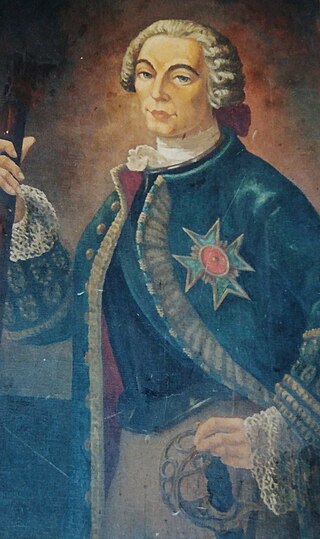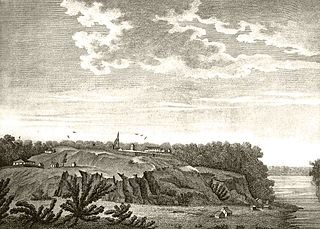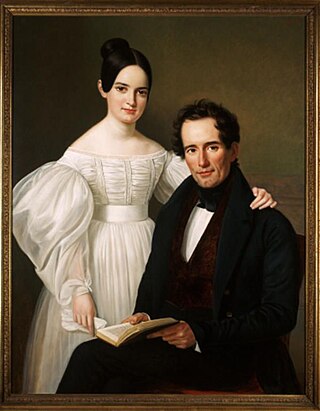
Natchez, officially the City of Natchez, is the only city in and the county seat of Adams County, Mississippi, United States. The population was 14,520 at the 2020 census. Located on the Mississippi River across from Vidalia in Concordia Parish, Louisiana, Natchez was a prominent city in the antebellum years, a center of cotton planters and Mississippi River trade.

Winthrop Sargent was a United States patriot, politician, and writer; and a member of the Federalist party.
The Natchez District was one of two areas established in the Kingdom of Great Britain's West Florida colony during the 1770s – the other being the Tombigbee District. The first Anglo settlers in the district came primarily from other parts of British America. The district was recognized to be the area east of the Mississippi River from Bayou Sara in the south and Bayou Pierre in the north.

Étienne Perier or Étienne de Perier (1686–1766), also known as Perier the Elder, was a French naval officer and governor of French Louisiana from 1726 to 1733. His time as governor included some notable achievements, including the construction of the first levee along the Mississippi River in 1727. In response to the Natchez Revolt, he attempted to completely destroy the Natchez people, which increased Native American hostility toward the French in the territory. Because he failed to secure the safety of the colony, Perier was recalled as governor in March 1733. He later distinguished himself as a naval officer and privateer, including during the capture of HMS Northumberland in 1744.

Fort Rosalie was built by the French in 1716 within the territory of the Natchez Native Americans and it was part of the French colonial empire in the present-day city of Natchez, Mississippi.

David Ker, born in northern Ireland, was a minister, educator, lawyer and judge, the first presiding professor of the University of North Carolina.
John Welch Jones, (1826–1916) was a medical doctor, Civil War cavalry officer, superintendent of the Insane Asylum of Louisiana, and planter. Jones led the reform of the care of mentally ill people in late nineteenth century Louisiana.
George Henry Clinton was a chemist, lawyer, and Democratic politician from St. Joseph in Tensas Parish in the northeastern Mississippi River delta of the U.S. state of Louisiana.
Edwin Adams Davis was an American historian who specialized in studies of his adopted state of Louisiana. A long-time professor at Louisiana State University in Baton Rouge, he was particularly known for two textbooks, Louisiana: A Narrative History and Louisiana: The Pelican State, the latter for middle schools and coauthored with Joe Gray Taylor of McNeese State University in Lake Charles, Louisiana.

Stephen Duncan was an American planter and banker in Mississippi. He was born and studied medicine in Pennsylvania, but moved to Natchez District, Mississippi Territory in 1808 and became the wealthiest cotton planter and the second-largest slave owner in the United States with over 2,200 slaves. He owned 15 cotton and sugar plantations, served as President of the Bank of Mississippi, and held major investments in railroads and lumber.
John Carmichael Jenkins (1809–1855) was an American plantation owner, medical doctor and horticulturalist in the Antebellum South.
Stephen Minor (1760–1815) was an American plantation owner and banker in the antebellum South.

Captain William J. Minor was an American planter, slave owner, and banker in the antebellum South. Educated in Philadelphia, he lived at the Concord plantation in Natchez, Mississippi, and served as the second President of the Agricultural Bank. He was the owner of three large sugar plantations in Louisiana and supported the Union during the Civil War for the stability of the sugar trade.
Concord was a historic mansion in Natchez, Mississippi. Built in 1789, it was the official residence of the Spanish Governors of Mississippi before it joined the United States. It was then acquired by the Minor family, who owned many Southern plantations, followed by a banker from New York. It burnt down in 1901.

Live Oak is a former plantation in Weyanoke, West Feliciana Parish, Louisiana, United States. The Live Oak Plantation House is one of the first houses in the Felicianas, built in 1808 with Spanish-influenced architecture, predating the American annexation of the Republic of West Florida in 1810. It is listed on the National Register of Historic Places under the name "Live Oak," as of March 11, 1977.

The city of Natchez, Mississippi, was founded in 1716 as Fort Rosalie, and renamed for the Natchez people in 1763.

The Boston Club is an exclusive private gentlemen's club in New Orleans, Louisiana, US, founded in 1841 as a place for its white members to congregate and partake in the fashionable card game of Boston. It is the third oldest City Club in the United States, after the Philadelphia Club (1834) and Union Club of the City of New York (1836).
Alexander King Farrar was a state senator, lawyer, plantation owner, and secession convention delegate in Mississippi.

Norman's chart of the lower Mississippi River is a historically significant map produced in 1858 of landmarks, roads, ferry crossings, and plantations along the course of the Mississippi River from Natchez to New Orleans. Cotton and sugar plantations are color-coded with distinct colors. The lithographic map is based on cartography by Marie Adrien Persac. The map was printed by longtime New Orleans bookseller Benjamin Moore Norman.

Edmund Jean Forstall was an American banker, merchant, and planter, from New Orleans, Louisiana, from a prominent Louisiana Creole family through his mother, and Irish heritage on his father's side. He is known for developing The Forstall System in 1842.













